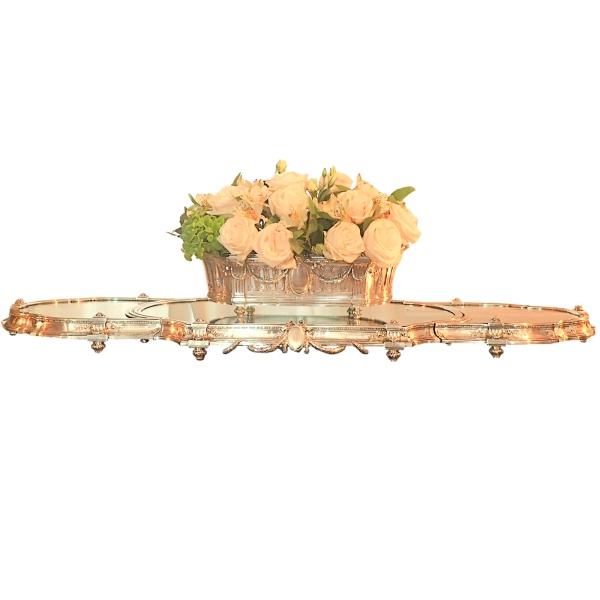Extraordinary Antique French Silver Surtout and Jardinière By Emile Puiforcat

An extraordinary Antique French Silver Surtout and Jardinière By Emile Puiforcat
The is the most Extraordinary complete Antique French Silver 3 pieces Surtout and matching Jardinière by Maître Orfèvre Emile Puiforcat we have seen in quite a while.
The sheer silver weight is astounding, and the wonderful design and skilled chiseling even more.
The four pieces are worked in the beautiful Louis XVI Style the edge with moved contours with silver swags and fluted pilasters holding garlands of laurel, while each side is centered with oval medallions pearled topped by a tied ribbon.
The carving of the Laurel taurus is also incredible in its work and beauty.
The Surtout consists of 3 pieces that are either usable together or can also be separated with only the center piece used. Each piece is lined with a mirror and backed in mahogany wood.
The oval Jardinière or flower center piece is decorated with the same pattern as the Surtout and has a silver metal lining. The lining of the Jardinière is made of silvered metal.
The Jardiniere measurements are as follows: Height 5.32 inches – length 16.34 inches- width 9.45 inches – Silver Weight 6.340 Pounds / Gross weight 9.15 pounds
The Surtout central part measurements are: Height: 2.56 inches – Length 26 inches – Width. 17 inches – Silver Weight 6.320 Pounds / Gross weight: 19 Pounds
Each Side part of the surtout measurements are: Height. 2.56 inches – Length: 13 inches – Width: 13.15 inches – Silver weight: 2.45 pounds / Gross weight: 5.85 Pounds
Total Silver weight: 17.56 Pounds / Total Gross weight 39.85 pounds
It is at the time of the Sun King, Louis XV, as described in the famous work the ‘Mercury’, that is defined the term ‘Surtout’ on the occasion of the reception given by duke of Orleans for the English ambassador in his residence of Saint-Cloud.
The ‘Surtout’ is originally a piece of silverware that gathers in the center of the table saltshakers, spice boxes and candleholders.
The reason of its appearance obeys a practical reason: the French service and its abundance of dishes and service.
Among the rotation of dishes, only the spices remain.
From there was born the idea of creating a fixed space that would become a wonderful pretext for the wildest decorative extravagances for the silversmiths of the eighteenth century, such as the one made by Just-Aurèle Meissonnier for the Duke of Kinston in 1735!
Under the First Empire, the pleasure of ‘taste’ is reinforced by the wonder of the eyes and the glitter of the top which is lined with mirror is used to reflect the light of the torches and candelabras.
Object of luxury, it remains the prerogative of goldsmiths. It is therefore logical that Emile Puiforcat, founder of the eponymous company, is part of this tradition.
The silversmith, based on rue Chapon in Paris, revives the great hours of French goldsmithing in a grandiose Louis XVI style. The amateurs of beautiful tables will be able to prepare the most incredible set up!
The Hallmark is Minerva 1-1st title (950/1000) – 1838 -1919– Paris
The Makers Mark is for Maître Orfèvre Emile PUIFORCAT, and was registered in 1857; it features an E and a P separated by a standing feather.
The mark is still so famous it does deserve a bit more explanations:
Emile PUIFORCAT inherited the business from his uncle Jean Baptiste FUCHS who specialized in flatware in the early 1800s. Emile Puiforcat moved from the offices of his uncle right next door at number 18, then 16 of Rue Chapon. While he died in 1883, his mark was kept by his successor as well as his grandson Jean, who passed away in 1945.
Until the 1880 the House of Puiforcat remained in the flatware business, but expended into the larger pieces to include presentations plates and platters.
Though very praised for its craftsmanship PUIFORCAT never participated in the Fairs that did so much for the Silver business in the 1800. The house continued on through the years and was finally bought by Hermes in 1993.
France 19th Century c.Reference number: CC-253
Click here to print.
go back
